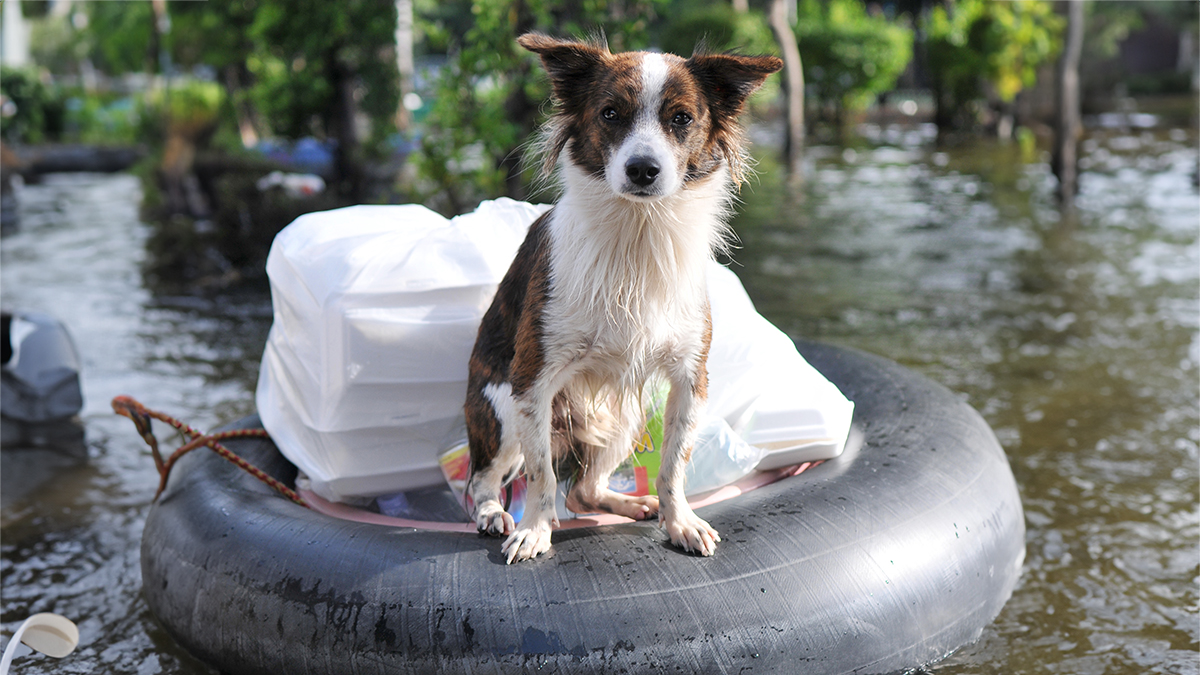What to know
- Evacuations due to natural disasters and other emergencies may result in a large number of displaced domestic animals.
- These animals can present multiple occupational safety and health hazards to emergency response and recovery workers.
- Workers can use these recommendations to prevent injury and illness during animal rescue and recovery efforts.

Overview
Following emergency situations, displaced domestic animals may be abandoned in residences, facilities, or outdoors. Many disaster shelters cannot accept pets because of state health and safety regulations. Displaced animals may be without food, water, supervision, and medical care for days or even weeks. Fear, panic, separation anxiety, and other behavioral disorders are common in displaced animals. They may exhibit unpredictable or aggressive behavior.
Who is at risk
Displaced domestic animals can present multiple occupational safety and health hazards to emergency response and recovery workers. Examples of these workers include:
- Animal handlers
- Animal shelter workers
- Firefighters
- Military personnel
- Police
- Veterinarians
- Veterinary technicians and assistants
Hazards
There are many potential health and safety hazards when working with displaced domestic animals. Some examples include:
Recommendations
General precautions
- Wash your hands frequently with soap and water, including:
- Before and after handling animals
- After coming into contact with animal saliva, urine, feces, or blood
- After cleaning cages or equipment
- Before eating, drinking, smoking, taking breaks, or leaving work
- After removing gloves
- Use alcohol-based hand sanitizers that contains at least 60% alcohol to clean hands when soap and water are not available
- Hand sanitizers are not as effective when hands are visibly dirty or greasy and might not remove all germs or chemicals
- Change into clean clothing before leaving the workplace
- Wear disposable outerwear or clothing that you can remove if clean clothing or laundry facilities are not available
Using scalpels, forceps, and other sharp instruments
- Dispose of sharp devices in labeled, puncture-resistant, leak proof sharps disposal containers immediately after use
- Do not recap, bend, or remove contaminated needles and sharps
- Do not shear or break contaminated needles
Lifting heavy or awkward loads
- Use proper lifting techniques
- Reduce the weight of loads when possible
- Work together to lift loads that are unsafe for one person to handle
Working with cleaners, disinfectants, and other chemicals
- Follow manufacturer's instructions and all product label precautions
- Make sure the area where you are working is well ventilated
- Wear appropriate personal protective equipment for the product and task
Working in a hot environment
- Know the symptoms and risk factors of heat-related illnesses
- Take time to acclimatize by gradually increasing time working in hot conditions over 1-2 weeks
- Stay hydrated
- Take frequent rest and hydration breaks in a cool area
Personal protective equipment
Gloves
Wear medical examination gloves when handling animals, animal waste, cages, equipment, and pesticides:
- Wear two pairs of gloves if one pair alone might tear
- Wear cotton or leather work gloves as the outer pair when heavy work gloves are needed
- Use latex gloves that are reduced-protein, powder-free gloves to reduce exposure to allergy-causing proteins
- Use non-latex gloves if you need or want to avoid latex
- Remember that cotton, leather, and other absorbent gloves are not protective when worn alone
Protective clothing
Wear sturdy clothing and protective footwear with non-slip soles. Tennis shoes or sneakers do not protect from bite, puncture, or crushing injuries.
Eye protection
Wear protective eyewear, like safety glasses with side shields or face shields.
Hearing protection
Wear hearing protection if you must raise your voice to talk to someone an arm's length away. For example, when working in enclosed spaces with barking dogs.
Care for animal bites and scratches
- Complete the rabies pre-exposure vaccination series before directly handling animals that may be infected with rabies.
- Thoroughly clean all bite wounds and scratches with soap and water.
- Report any bite injury to your supervisor.
- Immediately receive medical evaluation of any bite wound. Also evaluate the need for possible rabies post-exposure treatment and vaccination.
- Monitor bites or scratches for infection. Receive a repeat medical evaluation if infection occurs, especially if redness, inflammation, or swelling progresses rapidly.
Consult with a healthcare provider about any occupational injury or illness. Immediately report to the supervisor:
- Any needlestick or other sharps-related injury
- Any symptom(s) of infectious disease or zoonosis
- Any other workplace injury or illness
